
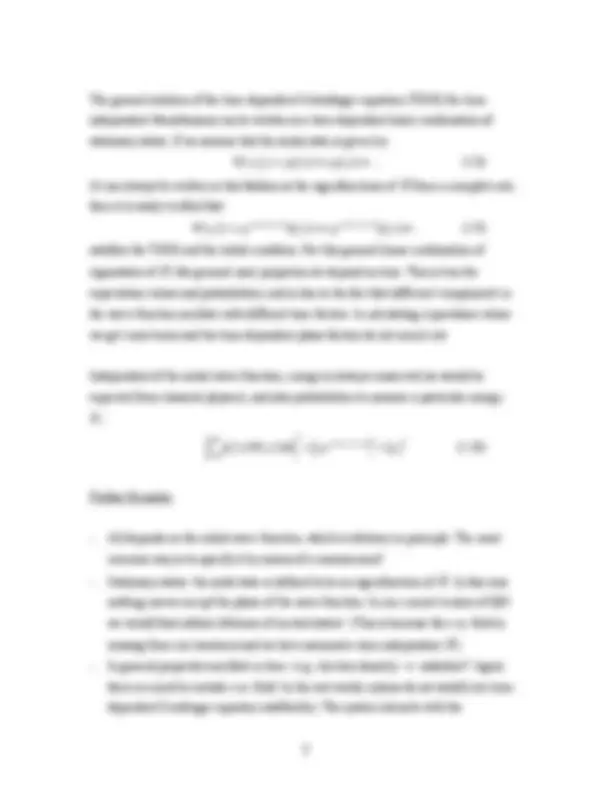
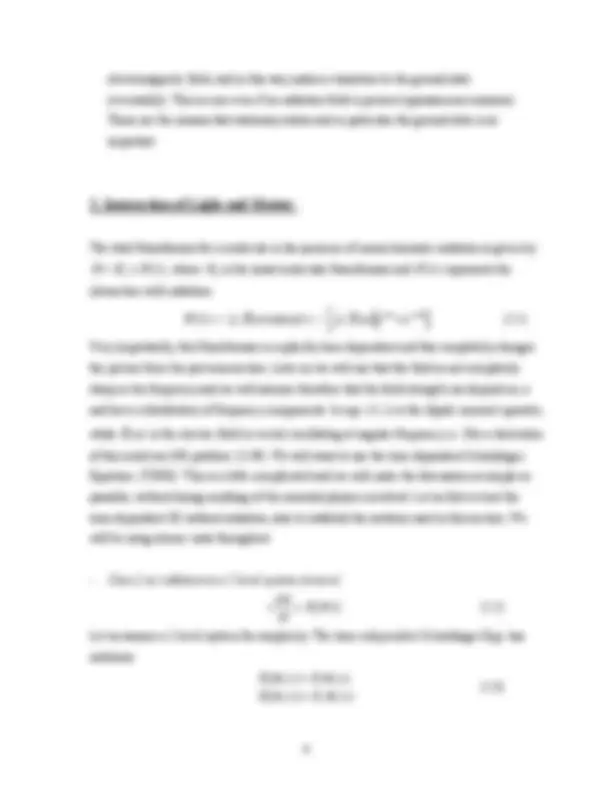
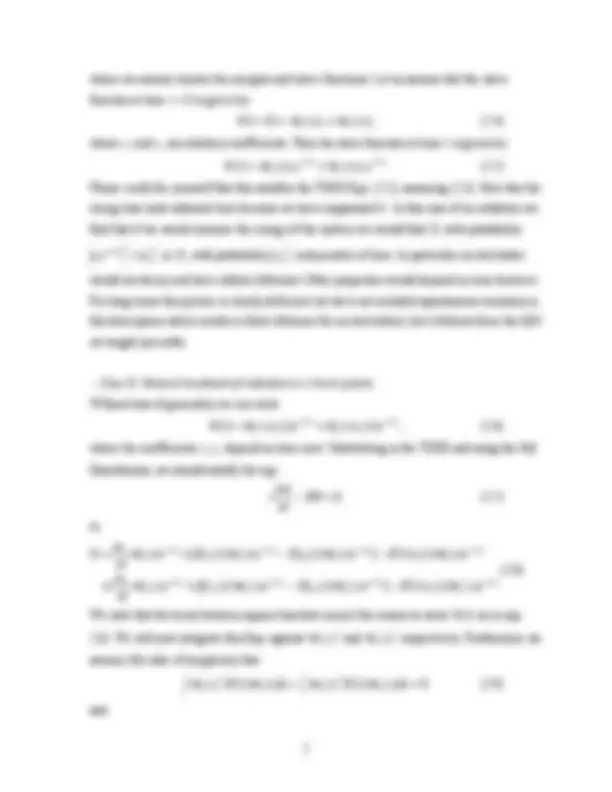
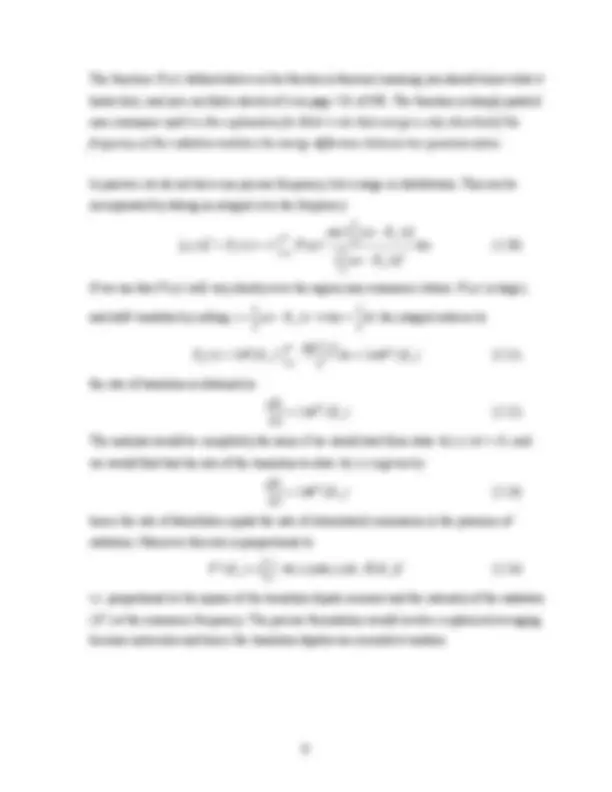

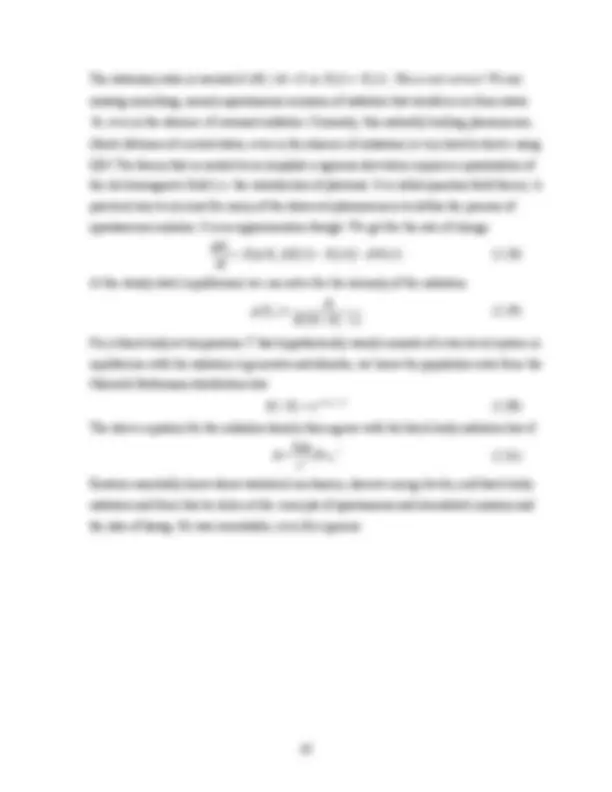
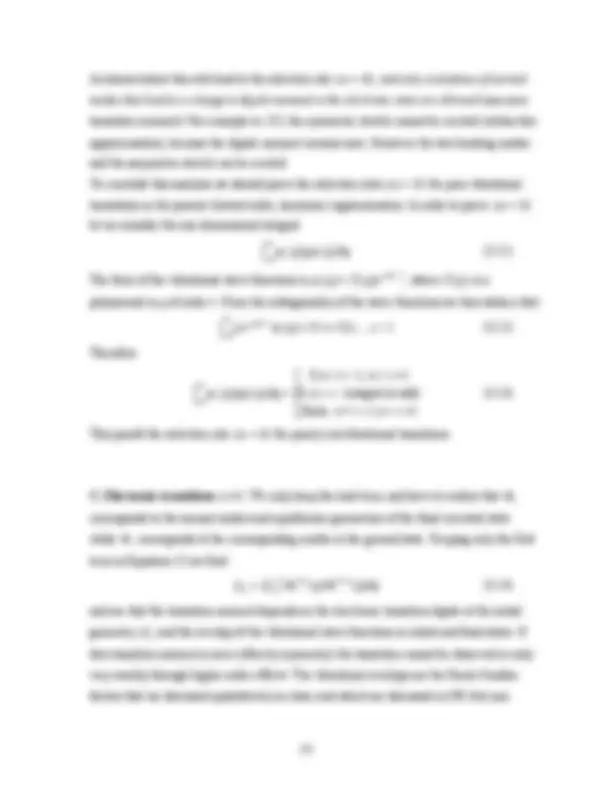



Study with the several resources on Docsity

Earn points by helping other students or get them with a premium plan


Prepare for your exams
Study with the several resources on Docsity

Earn points to download
Earn points by helping other students or get them with a premium plan
Community
Ask the community for help and clear up your study doubts
Discover the best universities in your country according to Docsity users
Free resources
Download our free guides on studying techniques, anxiety management strategies, and thesis advice from Docsity tutors
The time-dependent Schrödinger equation (TDSE) and its application to quantum transitions. The TDSE is a first-order differential equation that governs the time evolution of a quantum system, with the Hamiltonian operator determining the energy of the system. the wave function of a two-level system in the presence and absence of radiation, and the resulting rates of absorption and emission. It also touches upon the concept of spontaneous emission, which is challenging to derive using quantum mechanics.
What you will learn
Typology: Exercises
1 / 14

This page cannot be seen from the preview
Don't miss anything!









An important postulate in quantum mechanics concerns the time-dependence of the wave function. This is governed by the time-dependent Schrödinger equation
i h ∂Ψ∂^ ( , ) x tt^ = H $^ Ψ( , ) x t (1.1)
where H $ is the Hamiltonian operator of the system (the operator corresponding to the classical expression for the energy). This is a first order differential equation in t , which means that if we specify the wave function at an initial time t 0 , the wave function is determined at all later times. Let me emphasize that this means the wavefunction has to be specified for all x at initial time t 0. These initial conditions are familiar from wave equations as discussed in MS Chapter 2. In classical physics we often deal with second order differential equations and in addition the time derivative ∂Ψ ( , ) / x t ∂ t would then need to be specified for all x. Let me emphasize here that although the experimental results that can be predicted from QM are statistical in nature, the Schrödinger equation that determines the wave function as a function of time is completely deterministic.
======= Special solutions: Stationary States (only if H $ is time-independent).
can separate the time dependence from the spatial dependence of the wave function in the usual way. The separation constant is called E and will turn out to be the energy of the system for such solutions
equation (1.2) is called the time-independent Schrödinger equation and plays a central
role in all of chemistry. Since the operator H $ is Hermitean the eigenfunctions form a complete and (can be chosen to be an ) orthonormal set of functions. Using these
eigenfunctions of H $ special solutions to the time-dependent Schrödinger equation can be expressed as
For these special solutions of the Schrödinger equation, all measurable properties are independent of time. For this reason they are called stationary states. For example the probability distribution
but also
A^ $^ A $^ A $ t^ =^ t 0 ∀ ,^ (1.6) as is easily verified, by substituting the product form of the wave function. Also the probabilities to measure an eigenvalue a (^) k are independent of time, as seen below
The common element in each of these proofs is that the time-dependent phase factor cancels because we have both Ψ( , ) x t and Ψ*^ ( , ) x t in each expression. Let me note that the stationary solutions are determined by the initial condition. If you start off with a stationary state at t 0 , the wave function is a stationary state for all time.
electromagnetic field, and in this way makes a transition to the ground state (eventually). This occurs even if no radiation field is present (spontaneous emission). These are the reasons that stationary states and in particular the ground state is so important.
The total Hamiltonian for a molecule in the presence of monochromatic radiation is given by H = H (^) 0 + H '( ) t , where H 0 is the usual molecular Hamiltonian and H '( ) t represents the interaction with radiation:
H '( ) t = − r^ ⋅ E ( )cos( t ) = − ⋅ E ( ) e i^ t^ + e − i^ t
r (^) r r
Very importantly, this Hamiltonian is explicitly time-dependent and this completely changes the picture from the previous section. Later on we will use that the field is not completely
while
r
of this result see MS problem 13.49). We will want to use the time-dependent Schrödinger Equation. (TDSE). This is a little complicated and we will make the discussion as simple as possible, without losing anything of the essential physics involved. Let us first review the time-dependent SE without radiation, also to establish the notation used in this section. We will be using atomic units throughout.
i^ ∂∂Ψ t = H (^) 0 Ψ( ) t (2.2)
Let us assume a 2-level system for simplicity. The time- independent Schrödinger Eqn. has solutions H x E x H x E x
0 1 1 1 0 2 2 2
where we assume known the energies and wave functions. Let us assume that the wave function at time t = 0 is given by Ψ ( t = 0 ) = Φ 1 ( x c ) 1 (^) +Φ 2 ( x c ) 2 (2.4) where c 1 and c 2 are arbitrary coefficients. Then the wave function at time t is given by
Ψ ( ) t = Φ 1 ( x c e ) 1 − iE t^1^ +Φ 2 ( x c e ) 2 − iE t^2 (2.5) Please verify for yourself that this satisfies the TDSE Eqn. (2.2), assuming (2.3). Note that the energy has units radians/s here because we have suppressed h. In this case of no radiation we find that if we would measure the energy of the system we would find E 1 with probability
c e 1 − iE t^12 = c 12 , or E 2 with probability c 22 , independent of time. In particular excited states
would not decay and have infinite lifetimes! Other properties would depend on time however. For long times this picture is clearly deficient (we have not included spontaneous emission in this description which results in finite lifetimes for excited states), but it follows from the QM we taught you sofar.
i^ ∂∂Ψ t − H Ψ = 0 (2.7)
or
(^0 11) 1 1 1 0 1 1 1 1 (^22 2 2 2 0 2 2 2 )
1 1 1 1
2 2 2 2
− − − −
− − − −
i ct x e E c t x e H c t x e H t c t x e
i ct x e E c t x e H c t x e H t c t x e
iE t iE t iE t iE t
iE t iE t iE t iE t
We note that the terms between square brackets cancel (the reason to write Ψ( ) t as in eqn.
2.6). We will now integrate this Eqn. against Φ 1 ( x )and Φ 2 ( x )respectively. Furthermore we assume (for sake of simplicity) that
and
i ct V c t Vc t
i ct V c t Vc t
(^12 )
(^21 )
and hence we get second order equations ∂ ∂ = − ∂ ∂ = −
(^21) 2 1 (^22) 2 2
c t Vc^ t c t Vc^ t
with known solutions
where ϕ is determined by the initial values of c 1 (^) , c 2. Under these conditions the probabilities
to measure the energy E 1 or E 2 hence oscillate in time as cos (^2 Vt )and sin (^2 Vt )respectively. On average there is equal probability to find E 1 or E 2 , independent of the initial conditions. The oscillation time depends on V , i.e. it is proportional to the strength of the field and to the transition dipole! It does not depend on the energy difference between the two states or the frequency of the applied field.
II-B. Near resonance, short times, weak fields. If we assume that at t = 0 , Ψ ( t = 0 ) =Φ 1 ( x ), i.e. c 1 (^) = 1 ; c 2 = 0 , we can assume that c 1 remains more or less unity and integrate the equation for c 2 (^) ( ) t. This yields
c (^) 2 i (^) 0 V e i^ E^ t^ dt (^) i iV E ei^ E 21
= − τ ω = − ω^ τ
c V E e e V E E^
2 2 2 i^ E^ i^ E 212 2 212 21
2 212
(^221)
2 2
(^221)
21 2
2 2
( ) (^ cos(^ ) )^
( ) sin [^ (^ ) ]
( )
sin [ ( ) ] [ ( ) ]
= ω^ τ ω^ τ − −^ − = (^) − − − = (^) − −
− − −
(2.19)
looks like), and you can find a sketch of it on page 531 of MS. The function is sharply peaked near resonance and it is the explanation for Bohr's rule that energy is only absorbed if the frequency of the radiation matches the energy difference between two quantum states.
In practice we do not have one precise frequency, but a range or distribution. This can be incorporated by taking an integral over the frequency
c P V
2 2 21 2 2 d
(^221)
21 2
sin [ ( ) ] [ ( ) ]
∞
P 21 (^) V E (^) (^212) x x dx V E
2 ( ) 2 ( ) (^22221)
−∞
∞
the rate of transition is obtained as ∂ ∂ =
The analysis would be completely the same if we would start from state Φ 2 ( x )at t = 0 , and we would find that the rate of the transition to state Φ 1 ( x )is given by ∂ ∂ =
hence the rate of absorbtion equals the rate of (stimulated) emmission in the presence of radiation. Moreover this rate is proportional to
i.e. proportional to the square of the transition dipole moment and the intensity of the radiation ( E^2 ) at the resonance frequency. The precise formulation would involve a spherical averaging because molecules and hence the transition dipoles are oriented at random.
The stationary state is reached if dN (^) 2 / dt = 0 or N (^) 1 ( ) t = N (^) 2 ( ) t. This is not correct. We are missing something, namely spontaneous emission of radiation that would occur from states Φ 2 even in the absence of resonant radiation. Curiously, this naturally looking phenomenon (finite lifetimes of excited states, even in the absence of radiation) is very hard to derive using QM. The theory that is needed to accomplish a rigorous derivation requires a quantization of the electromagnetic field (i.e. the introduction of photons). It is called quantum field theory. A practical way to account for many of the observed phenomena is to define the process of spontaneous emission. It is an approximation though. We get for the rate of change dN dt B^ E^ N^ t^ N^ t^ A N^ t
At the steady state (equilibrium) we can solve for the intensity of the radiation
For a black body at temperature T that hypothetically would consists of a two-level system in equilibrium with the radiation it generates and absorbs, we know the population ratio from the Maxwell-Boltzmann distribution law N (^) 1 / N (^) 2 = e − h^^ ν^12 / kT (2.30) The above equation for the radiation density then agrees with the black-body radiation law if
Einstein essentially knew about statistical mechanics, discrete energy levels, and black body radiation and from this he deduced the concepts of spontaneous and stimulated emission and the idea of lasing. He was remarkable, even for a genius.
A rigorous treatment of electromagnetic radiation (oscillating field) involves the time- dependent Schrödinger equation, usually in the form of time-dependent perturbation theory (see MS and lecture notes in previous section). At a given instant in time the electric field is more or less constant over the region of a (small) molecule, as the wavelength of the radiation (> ~200 nm) is so large compared to molecular dimensions. The relevant quantity that determines intensities in the spectrum is the transition dipole moment between initial and final states
Here Ψint^ indicates the total internal wave function involving both nuclear and electronic coordinates, but not the rotational part of the wave function. Similarly
α α
= (^) ∑ q r^ r^ , (3.2)
the total dipole moment operator involves both nuclei and electrons (indicated through
electrons: normal modes: molecular rotation: R
r
r
r q
i i (3.3)
and the overall internal wavefunction (disregarding rotations) can be written (approximately) as Ψ av int^ = Ψ a (^) ( ; r q r^ )Φ (^) v ( ) q , (3.4) The electronic wave function Ψ a ( ; r q^ r^ )depends on all of the electrons and in addition there is a parametric dependence of the electronic wavefunction on the normal modes (internal coordinates) q. The vibrational part Φ v ( ) q = φ (^) v (^) 1 ( q 1 (^) ) φ v 2 ( q 2 )....is assumed a product of
harmonic oscillator functions for each normal mode qi. If we do not use a subscript we
Ω (^) J M , (^) J ( , θ ϕ) determines the probability distribution of the orientation of the molecule in
space. This rotational part is treated differently from the rest. Let us first discuss the problem at a fixed orientation. We can write the overall transition moment in (3.1) as
As shown below this will lead to the selection rule ∆ v = ± 1 , and only excitations of normal modes that lead to a change in dipole moment in the electronic state are allowed (non-zero transition moment)! For example in CO 2 the symmetric stretch cannot be excited (within this approximation), because the dipole moment remains zero. However the two bending modes and the assymetric stretch can be excited. To conclude this analysis we should prove the selection rules ∆ v = ± 1 for pure vibrational transitions in the present (lowest order, harmonic) approximation. In order to prove ∆ v = ± 1 let us consider the one-dimensional integral
polynomial in q of order v. From the orthogonality of the wave functions we then deduce that
Therefore
ϕ (^) w q q ϕ (^) v q dq
w v w v w v w v w v
−∞
∞
integral is odd) finite, = -
This proofs the selection rule ∆ v = ± 1 for purely (ro)vibrational transitions.
C. Electronic transitions a ≠ b. We only keep the lead term, and have to realize that Φ w corresponds to the normal modes and equilibrium geometries of the final (excited) state while Φ v corresponds to the corresponding modes in the ground state. Keeping only the first term in Equation (7) we find
and see that the transition moment depends on the electronic transition dipole at the initial
this transition moment is zero (often by symmetry) the transition cannot be observed or only very weakly through higher order effects. The vibrational overlaps are the Frank-Condon factors that we discussed qualitatively in class, and which are discussed in MS (but you
should include the phase information in their figures!). The actual calculation is quite involved because the integral does not factorize if the normal modes are different in the two electronic states.
Discussion of rotational selection rules.
The orientation of the transition dipole μr (^) fi depends on the orientation of the molecule in
space, in particular with respect to the electric field. The probability distribution for the
the discussion let us consider purely rotational transitions, so that μr (^) fi is just the permanent
dipole of the molecule. A classical dipole would start rotating under influence of an
the transition dipole moment and the electric field. In the quantum world this interaction
governed by the by the transition moment
As discussed in MS, for diatomics these matrix elements are non-vanishing only for ∆ J = ± 1 , ∆ M = 0. These are properties of the spherical harmonics, nothing mysterious.